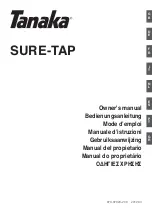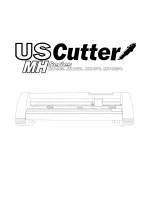
41
OPERATION
Applications
The tool is intended for dry cutting of slots in stone materials, concrete and asphalt etc. The tool can be
used to route electric cables or water pipes in walls or floors, and for cutting out tiles.
The tool can also be used to cut tiles.
Fitting diamond discs
(fig. 1 to 5)
NOTE:
Switch off the tool, unplug the power cord, and wait until all moving parts have completely stopped
and the discs have cooled. Wear safety gloves.
1.
Remove all the screws (13) with the supplied hex key.
2.
Remove the clamping screw for the sliding depth stop (11). Take care not to misplace washers and
locking washers.
3.
Remove the protective cover (8) and turn down the sliding depth stop (10).
4.
Press in the spindle lock button (fig. 2, position 19).
5.
Remove the flange nut (6) with the spanner (21). Note that the screw has a left-hand thread.
6.
Remove the first diamond disc, the spacer washers (5) and the other diamond disc.
7.
Clean the motor flange (3), spacers and spindle sleeve (4).
8.
Put the motor flange (3) and spindle sleeve (4) on the spindle (2). Fit the spindle sleeve correctly in
the motor flange.
9.
Place a diamond disc (7) on the motor flange.
NOTE:
Check that the arrow on the diamond disc
points in the same direction as the arrow on the protective casing (8).
10.
Put the required number of spacers on the spindle. Put the other diamond disc on the spindle and
then the remaining spacers (fig. 5). The slot width is determined by the number of spacers (5)
between the two diamond discs.
NOTE:
There must be at least one spacer between the two diamond
discs. All the spacers must be fitted on the spindle, irrespective of the distance between the discs.
NOTE:
Do not put any spacers between the motor flange and the first diamond disc.
11.
Screw the flange nut (6) on the spindle and tighten by hand.
12.
Fit the flange nut (6) with the side with the raised edge to the diamond disc, so that the disc is locked
in place.
13.
Press in the spindle lock button (19) and tighten the flange nut with the spanner (21).
14.
Turn up the sliding depth stop (10) and replace the protective cover (8). Lock the sliding depth stop
in place with the hex screws (13).
IMPORTANT:
Do not forget the washers and locking washers.
Replace the clamping screw for the sliding depth stop (11).
NOTE:
Both diamond discs must always
be replaced at the same time.
Depth setting
(fig. 6)
NOTE:
Unplug the power cord, switch off the tool, and wait until all moving parts have completely stopped.
1.
Remove the clamping screw for the sliding depth stop (11) and adjust to the required depth.
2.
Tighten the clamping screw for the sliding depth stop (11). Adjust to a 3 mm larger depth than what
is needed, to compensate for any irregularities on the wall surface.
Starting/Stopping
(fig. 7)
NOTE:
Run the tool for at least 30 seconds with no load before starting the work.
STARTING Press in the power switch lock (16) and press in the power switch (17). The tool is fitted
with a soft start device.
STOPPING Release the power switch.
The tool is equipped with overheating protection and switches off automatically if it is overloaded. Remove
the tool from the workpiece if this happens. Run the tool with no load for about 1 minute to cool it.
Adjusting the slot width
(fig. 4–5)
The tool has two spacers (5) which are approximately 10 and 15 mm thick.
1.
Adjust the slot width by fitting one or more spacers between the diamond discs (7).
2.
The slot width is the thickness of the spacers plus the width of the diamond discs (see below). The
maximum slot width is approx. 29 mm.
IMPORTANT:
Never attempt to fit more than 2 diamond discs on the spindle.
Slot width 14 mm 1 spacer 10 mm between the diamond discs / 1 spacer 15 mm outside.
Slot width 19 mm 1 spacer 15 mm between the diamond discs / 1 spacer 10 mm outside.




































